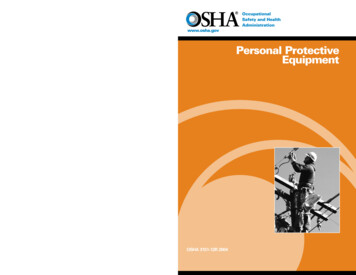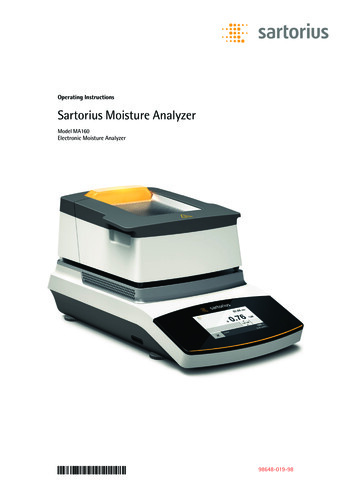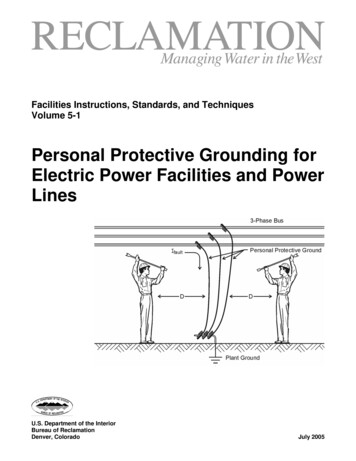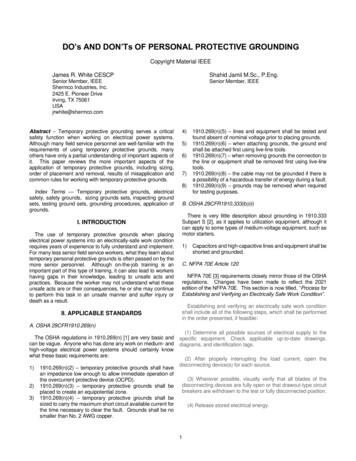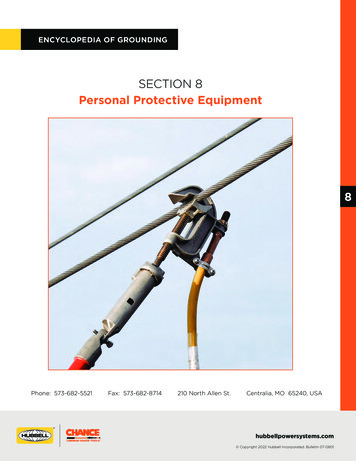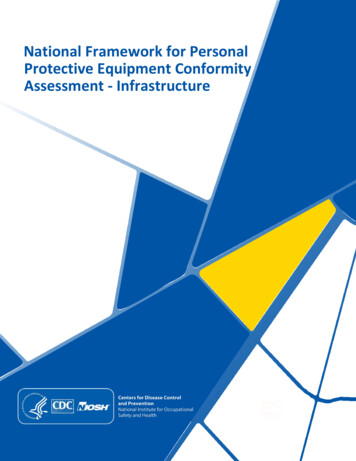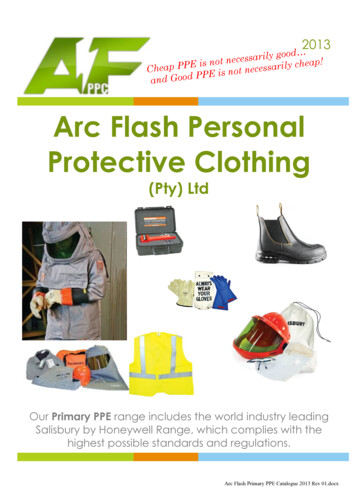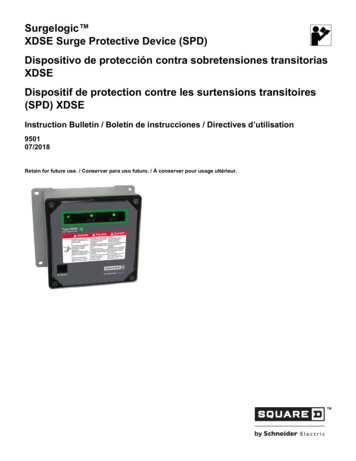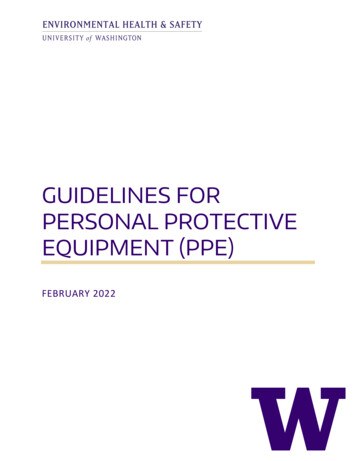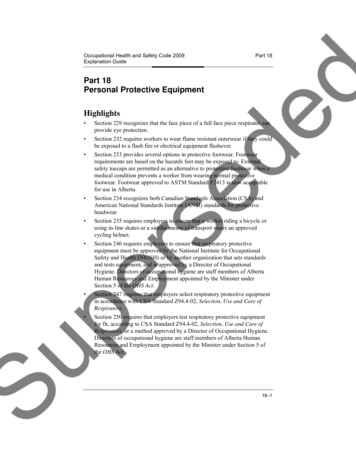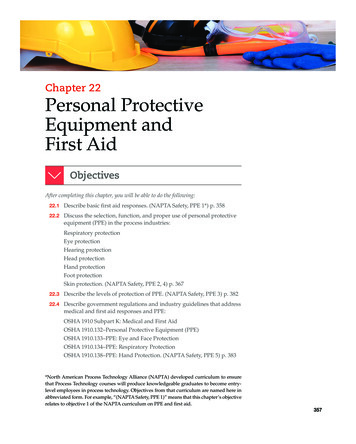
Transcription
Chapter 22Personal ProtectiveEquipment andFirst AidObjectivesAfter completing this chapter, you will be able to do the following:22.1 Describe basic first aid responses. (NAPTA Safety, PPE 1*) p. 35822.2 Discuss the selection, function, and proper use of personal protectiveequipment (PPE) in the process industries:Respiratory protectionEye protectionHearing protectionHead protectionHand protectionFoot protectionSkin protection. (NAPTA Safety, PPE 2, 4) p. 36722.3 Describe the levels of protection of PPE. (NAPTA Safety, PPE 3) p. 38222.4 Describe government regulations and industry guidelines that addressmedical and first aid responses and PPE:OSHA 1910 Subpart K: Medical and First AidOSHA 1910.132–Personal Protective Equipment (PPE)OSHA 1910.133–PPE: Eye and Face ProtectionOSHA 1910.134–PPE: Respiratory ProtectionOSHA 1910.138–PPE: Hand Protection. (NAPTA Safety, PPE 5) p. 383*North American Process Technology Alliance (NAPTA) developed curriculum to ensurethat Process Technology courses will produce knowledgeable graduates to become entrylevel employees in process technology. Objectives from that curriculum are named here inabbreviated form. For example, “(NAPTA Safety, PPE 1)” means that this chapter’s objectiverelates to objective 1 of the NAPTA curriculum on PPE and first aid.M22 NAPT2498 02 SE C22.indd 35735721/05/19 3:57 PM
358 Chapter 22Key TermsCPR—cardiopulmonary resuscitation, which is an emergency method to assist avictim whose heart has stopped beating properly, p. 366.First-degree burns—burns that affect only the outer layer of skin and cause pain,redness, and swelling, p. 362.Second-degree burns—burns that affect both the outer and the underlying layer ofskin, p. 362.Third-degree burns—burns that affect deeper tissues and cause white or blackened,charred skin that may be numb, p. 362.22.1 IntroductionOSHA requires that employees be given a safe and healthy workplace that is reasonably freeof occupational hazards. However, process technicians can be exposed to chemical, biological,physical, and ergonomic hazards inherent to working in a process facility. Although everyeffort is made to prevent accidents and emergencies, they can still occur on the job, becausea process industry work site can pose a variety of potential hazards.Company policies and procedures determine whether process technicians can providefirst aid to victims. Often, an emergency response team (or first responders) and/or a resident medical staff will handle emergencies and accidents, including first aid treatment.At the very least, the process technician must promptly report emergencies and accidents tothe proper authorities. Your company will train you on how to report emergency situationsand accidents, along with other basic emergency procedures (potentially including first aidtraining).Note: This book is not intended to be a first aid or medical guide. Its goal is to informprocess technicians of potential emergencies and accidents they might encounter, so theycan report useful information to trained first responders or medical staff.To prevent or minimize hazards, government and the process industries have implemented engineering controls, administrative controls, and the use of personal protectiveequipment (PPE). Process technicians must understand the proper selection, use, care, andmaintenance of PPE. This chapter describes different types of PPE, levels of PPE protection,proper fit and use, and upkeep of PPE.Potential Injuries and Basic First AidIn a typical process facility, workers routinely perform tasks that, if not performed safely orproperly, might cause injuries. Physical hazards are common; they come from environmentalfactors such as excessive levels of noise, temperature, pressure, vibration, radiation, electricity, or machinery. This chapter discusses some potential types of injuries that can occur,although the nature and severity of an injury varies due to the hazard agent (the substance,method, or action by which damage can happen to personnel) and site-specific conditions(e.g., work environment, processes, materials, and equipment).Often, injuries result in minor cuts, pinches, scrapes, bruises, burns, strains, or splinters(Figure 22.1). However, in rare cases more serious injuries can occur. The following are sometypes of injuries and emergency situations that can occur in the process industries: Eye injuries Lacerations, punctures, or other causes of bleeding Impact injuries (bruises, sprains, or fractures) Back injuriesM22 NAPT2498 02 SE C22.indd 35821/05/19 3:57 PM
Personal Protective Equipment and First Aid359 Burns Head injuries Electric shocks Breathing problems Injuries from contact with chemical or biological substancesFigure 22.1 Every facility hasmaterials for first aid. Some ofthe most common injuries in theprocess industries include cuts,pinches, scrapes, bruises, burns,strains, or splinters.CREDIT: Omphoto/Shutterstock.Regardless of the type of injury that you or a fellow worker sustain, you must f ollowyour facility’s procedures for obtaining trained help and reporting the injury. (OSHA requirescertain types of injuries to be recorded.) Following are some general recommendations fordealing with injuries in the workplace: Report the situation immediately to the proper authorities, as outlined in your company’spolicies and procedures. Provide as much accurate information as possible about thelocation, situation, and victim’s status and symptoms. Make sure the scene is safe. Do not rush to help if doing so would put you or someoneelse in danger (e.g., live electric wires in contact with the victim). If properly trained and company policies and procedures permit, administer first aid. Do not move a victim unless a critical situation threatens the victim (e.g., fire, threat ofexplosion, hazardous atmosphere). Remember to use proper PPE and follow safety procedures while dealing with the situation, so you do not become a victim also. Remain calm and observant. Provide a full and accurate report on the situation and/or assist with any investigation.The following are general descriptions of each type of injury. To learn more about theseinjuries and their treatment, check with your employer about available first aid courses. TheAmerican Red Cross and National Safety Council also offer courses to the public. For additionaltraining, you can enroll in an emergency medical technician (EMT) or paramedic program.Eye InjuriesEye injuries can occur when a foreign object or substance comes into contact with the eye.Flying particles or falling objects, such as chips, metal shavings, dust, and other similar hazards are common causes of injury, according to the Bureau of Labor Statistics. Often, theseobjects are tiny and are moving fast (e.g., being thrown by a moving equipment part). Sparks(e.g., from tasks such as welding and grinding) can also strike the eye and cause damage.Contact with chemicals and other hazardous substances (e.g., molten metal, biologicalagents) is another common cause of eye injuries. Other accidents are caused by swingingobjects (e.g., ropes, chains) that strike the eye.M22 NAPT2498 02 SE C22.indd 35921/05/19 3:57 PM
360 Chapter 22The eyes can be protected from injury using PPE such as safety glasses, safety goggles,or face shields (Figure 22.2). Eyewash stations (like drinking fountains, but with two streams)can be used to help with eye injuries. See the PPE section in this chapter for details.Figure 22.2 Safety glasses,safety goggles, and face shieldsprotect the eyes from injurycaused by flying debris.CREDIT: Mihai Daniel/Shutterstock.Injuries That Cause BleedingMost bleeding occurs from minor cuts, scrapes, punctures, or gashes (Figure 22.3). Bleedingcan be mild or severe. The hands are a common place for injuries to occur. If you step on asharp object, your foot can be punctured. Thrown or falling objects can cause impact injuries(bruises, fractures), sometimes accompanied by bleeding. Severe cuts (such as to an artery)can cause a victim to bleed profusely, pass out, and even die.Figure 22.3 Most bleedingoccurs from minor cuts, scrapes,punctures, or gashes that can betreated with first aid equipment.CREDIT: Bmf-foto.de/Shutterstock.A variety of hazards in the process industries can cause injuries that bleed: using tools,coming into contact with moving equipment parts, getting hit by a thrown or fallen object,or getting a body part caught between two hard surfaces.The hands can be protected from injury by using gloves. Feet can be protected by wearing safety footwear. Other body parts can be protected by other types of PPE. See the PPEsection in this chapter for details.Impact InjuriesImpact can occur in a variety of ways. The worker may be hit by thrown or falling objects.A worker might drop materials he or she is carrying (e.g., pipes, drums, and bags). WorkersM22 NAPT2498 02 SE C22.indd 36021/05/19 3:57 PM
Personal Protective Equipment and First Aid361can slip or trip or fall from a height. Workers might also be involved in a vehicle accident.Impact can result in injuries such as the following: Bruises Bleeding Strains Fractures In extreme cases, deathEven a short fall of 3 to 4 feet (1–1.3 m) can cause a major injury or even death. Also, ifa person is working at heights and using fall protection, a fall can still cause impact injuries(e.g., from the harness violently jerking against a body part) (Figure 22.4).Figure 22.4 A. Safety harness. B. Process technicians should always wear proper PPE when working at heights.CREDIT: A. Paulo Vilela/Shutterstock. B. Alessia Pierdomenico/Shutterstock.A.B.OSHA requires workers to be trained and wear fall protection in most cases when working at a height of 4 feet (1.3 m) or more unless handrails or similar barriers are present. Youremployer will provide and train you in proper use of fall protection equipment.Various PPE can be used to protect workers against impact injuries. Such PPE includehard hats, gloves, safety shoes, fall protection, and safety glasses, goggles, or face shields.See the PPE section in this chapter for details.Back InjuriesBack injuries can range from minor to serious. Some require rest and other simple treatments, while severe ones can result in surgery, permanent disability, or death. Back injuriescan occur in any situation, whether the work environment is a process unit or an officeenvironment. They are not always caused by lifting heavy objects or performing laborioustasks; even something as simple as bending over to pick up a dropped object can cause aninjury (Figure 22.5).M22 NAPT2498 02 SE C22.indd 36121/05/19 3:57 PM
362 Chapter 22Figure 22.5 Many backi njuries occur as a result ofimproper lifting technique.CREDIT: (left) PHOVOIR/Alamy Stock Photo.(right) Hero Images Inc./Alamy Stock Photo.INCORRECT LIFTINGCORRECT LIFTINGThe following are some situations that can potentially result in a back injury: Lifting or handling materials incorrectly Using tools improperly Slips, trips, and falls Falling from heights Impact (e.g., falling objects, getting caught between two hard surfaces) Twisting the body in an unnatural position Vehicle accidents Bending overFirst-degree burns burns thataffect only the outer layer of skin andcause pain, redness, and swelling.Second-degree burns burnsthat affect both the outer and theunderlying layer of skin.Third-degree burns burns thataffect deeper tissues and cause whiteor blackened, charred skin that maybe numb.Although a back belt can be used, following proper ergonomic practices is the betterapproach to prevent or minimize a back injury. See Chapter 15, Recognizing Ergonomic Hazards for more details. Check your company’s policy on the use of back belts. Proper footwearcan help prevent slips and falls, while fall protection can minimize injuries due to falls fromheights.BurnsThere are three levels of burns. A first-degree burn affects only the outer layer of skin andcauses pain, redness, and swelling. A second-degree burn affects both the outer and theunderlying layer of skin. These burns cause pain, redness, swelling, and blistering.A third-degree burn affects deeper tissues and causes white or blackened, charred skin thatmay be numb (Figure 22.6).SKIN BURNFigure 22.6 There are threelevels of burns.CREDIT: eburnM22 NAPT2498 02 SE C22.indd 362Second-degreeburnThird-degreeburn21/05/19 3:57 PM
Personal Protective Equipment and First Aid363Burns can be caused by fire, hot steam or liquids, radiation, friction, heated objects, thesun, electricity, or chemicals. Thermal burns are the most common type of burn in the processindustries. They occur when hot metals, liquids, steam, or flames come in contact with theskin. Because there is a large amount of hot piping and steam release within a plant, thermalburns occur frequently.Various types of PPE can be used to prevent or minimize the hazards of burns, such asthe following: Flame resistant clothing (FRC) Specially cooled clothing Gloves Safety footwear Helmets or masks Tinted face shields, safety goggles, or safety glasses Protective (barrier) creamsRespiratory protection can provide a barrier against flame related hazards such as smokeor vapor. See the PPE section in this chapter for details.Head InjuriesHead injuries can occur in the plant due to situations such as the following: Impact (e.g., thrown or falling objects, getting caught between two hard surfaces) Slipping or tripping Falling from a height A vehicle accidentHead injuries can be minor or major, but even a minor head injury can result in a moresevere condition, such as concussion, blackout, or disorientation. Major head injuries canresult in permanent disability or death. Head injuries can also include neck or spine injuries.All head injuries should be considered as major until a professional medical person can provide diagnosis and treatment. The most common type of PPE to prevent or minimize headinjuries is the hard hat. See the PPE section in this chapter for details.Electrical ShocksElectrical hazards can result from situations such as the following: Improper wiring or grounding Short circuits (Figure 22.7)Figure 22.7 Electrical shortscan produce fire and electricalshock hazards.CREDIT: Markik/Shutterstock.M22 NAPT2498 02 SE C22.indd 36321/05/19 3:57 PM
364 Chapter 22 Cracked, degraded, or wet insulation Surges and overloads Equipment failure Static electricity buildup Downed power lines Lightning strikesAn electrical shock occurs when a person is exposed to electric current. Electrical shockand other electrical hazards occur when a person contacts a conductor carrying electricitywhile also touching the ground or an object that has a conductive path to the ground. Theperson completes the circuit as the current passes through his or her body. Following aresome symptoms of electrical shock: Unconsciousness Cessation of breathing Weakness Weak or absent pulse Stopped heart Burned skin Stiffness of muscles in the bodyBesides burns, electrical shock can cause muscle damage, ventricular fibrillation (rapid,irregular contractions of the heart), cardiac arrest, cessation of breathing, and death. If yousee a victim of an electrical shock, DO NOT touch the victim. Make sure the power sourceis turned off immediately. DO NOT use wood, tree limbs, or plastic to push, pull, or roll thevictim away from the source of electricity. The moisture in the material can conduct electricity and electrocute the rescuer. High voltage can arc or jump up to three feet (about a meter)through the air, so make sure the power is off before attempting to help. PPE can prevent orminimize the hazard of electrical shocks: Hard hats Insulated gloves Safety footwear (nonconductive)See the PPE section in this chapter for details.Breathing ProblemsBreathing problems can result from a variety of causes, including exposure to hazardous chemicals in the atmosphere, air pollution, allergens, extreme temperatures, pressurechanges, and overexertion.Breathing troubles can result in the following conditions: Coughing and wheezing Sneezing Shortness of breath or gasping Gagging Vomiting Loss of consciousness Turning blue (a condition called cyanosis) DeathM22 NAPT2498 02 SE C22.indd 36421/05/19 3:57 PM
Personal Protective Equipment and First Aid365The following are some hazardous atmospheres the process technician might encounter: Smoke Airborne substances or chemicals (toxic or nontoxic) Oxygen-deficient environment Oxygen-enriched environmentRespiratory protection can provide a barrier between a worker and hazardous atmospheres or supply air at the correct oxygen level (Figure 22.8).Figure 22.8 Respiratoryprotection can provide a barrierbetween a worker and hazardousatmospheres.CREDIT: Science photo/Shutterstock.Contact with Chemical or Biological SubstancesWorkers handling chemicals and/or biological substances can come into contact withthese substances. The effects will vary, based on factors such as the type of substance, theamount of the substance, the type of exposure (e.g., inhalation, absorption), and the lengthof exposure. See Chapter 3, Recognizing Chemical Hazards and Chapter 4, Recognizing Biological Hazards for more details.Various types of PPE can be used to prevent or minimize exposure to these substances: Chemical suits, biohazard suits, or similar clothing and gear Respiratory protection Hard hats Gloves Safety footwear Face shields, safety goggles, or safety glassesEyewash stations can be used to remove any chemical or biological substances in or nearthe eyes, while safety (deluge) showers can be used to remove such substances from the body.See the PPE section in this chapter for details.Other InjuriesThe following are some other potential injuries and emergency situations: Cessation of breathing Stopped heartbeat Shock ChokingM22 NAPT2498 02 SE C22.indd 36521/05/19 3:57 PM
366 Chapter 22CPR cardiopulmonary resuscitation,which is an emergency methodto assist a victim whose heart hasstopped beating properly.Trained personnel can administer CPR (cardiopulmonary resuscitation) to victimswho have stopped breathing and/or have no heartbeat. Administering CPR properly andpromptly can make the difference between life and death. You can become CPR-certifiedthrough your company’s program or other outside agency (e.g., Red Cross).Shock is different from an electrical shock. This life-threatening medical emergencyresults in bodily collapse or near collapse that comes from an inadequate delivery of oxygento the body’s systems. Shock victims require immediate medical attention, or permanentdisability or death can happen. Always be alert for signs of shock when dealing with anyinjury. Shock can appear in a variety of ways: Weakness Pale, cold, and/or clammy skin Cyanosis (turning blue) Chills Vomiting Shallow or rapid breathing Change in body temperature (high or low) Change in heart rate (fast or slow) Chest pain Restlessness Personality change Mental confusion ComaChoking is caused by food or an object blocking a person’s upper airway, which preventsproper breathing. A first aid technique called the abdominal thrust or Heimlich maneuver( Figure 22.9) can be performed on a choking victim to dislodge the trapped object fromthe airway.Figure 22.9 Abdominalthrusts (Heimlich maneuver) canbe performed on a choking victimto dislodge a trapped object fromthe airway.CREDIT: SpeedKingz/Shutterstock.Choking signs include the following: Inability to talk Clutching the throat with one or both hands (this is the universal choking sign) Wheezing or coughing PanicM22 NAPT2498 02 SE C22.indd 36621/05/19 3:57 PM
Personal Protective Equipment and First Aid367 Wild gestures Turning blue Loss of consciousnessAs stated previously, usually only trained personnel should attempt any first aidt reatment, including CPR or the Heimlich maneuver. CPR and first aid skills should beupdated regularly because treatment methods change, and technology provides better waysto help people (e.g., automatic external defibrillators, or AED). There is a new technique forthe untrained rescuer, however. It is known as “compression only CPR.” It can be used ifthere is no one available who knows proper first aid and if trained responders are delayed.Push forcefully down on the nonbreathing victim’s chest in the center of the breastbone and compress the chest 2 to 2.4 inches (5-6 cm) deep. Compressions should be done at a rate of100 to 120 pumps per minute. This can be very frightening to the person performing therescue, but taking action could save a life. Irreversible brain damage and death can resultfrom doing nothing when a person’s brain is deprived of oxygen.22.2 Personal Protective EquipmentPersonal protective equipment (PPE) is specialized clothing and equipment worn or used byworkers to minimize the risk of injury from exposure to various hazards in the workplace,including chemical, physical, biological, and ergonomic hazards. In industry there are situations in which engineering controls (technological and engineering improvements used toisolate, lessen, or remove a hazard) and administrative controls (e.g., policies, procedures,and activities) do not effectively reduce the worker’s exposure down to acceptable levels. Inthese situations, OSHA regulations require use of personal protective equipment to reduceemployee’s exposure to hazards. PPE is considered the last line of defense against workplacehazards (see Figure 22.10).Figure 22.10 Personal rotective equipment minimizespthe risk of injury from exposure tovarious hazards in the workplace.CREDIT: Yustus/Shutterstock.The following are different types of PPE that may be provided to the process technician: Respiratory protection: air-supplying respirators and air-purifying respirators Hearing protection: earmuffs, disposable earplugs, reusable molded earplugs, helmets Eye protection: safety glasses, safety goggles, face shields Face protection: face shields, helmets, masksM22 NAPT2498 02 SE C22.indd 36721/05/19 3:57 PM
368 Chapter 22 Head protection: hard hats, bump caps Body and skin protection: chemical suits, flame resistant clothing, aprons, slickers Hand protection: chemical- and liquid-resistant gloves, leather or canvas gloves, insulated gloves Foot protection: safety shoes or boots, rubber boots, nonconductive footwearTwo main groups are responsible for promoting standards that PPE must meet to provide proper protection: The National Institute for Occupational Safety and Health (NIOSH) is a governmentagency that carries out research and training and recommends new standards and criteria to OSHA. NIOSH standards are used for respirators. The American National Standards Institute (ANSI) is an organization that develops andpromotes standards in a wide variety of areas, including PPE.OSHA requires that many categories of PPE meet or be equivalent to ANSIstandards: Eye and Face Protection—ANSI Z87.1-1989 Head Protection—ANSI Z89.1-1986 Foot Protection—ANSI Z89.1-1991No ANSI standards are available for hand protection, so gloves should be selectedbased on the task to be performed and the glove’s performance and constructioncharacteristics.When PPE is required, a PPE program should be implemented according to OSHA. (SeeChapter 3, Recognizing Chemical Hazards and Chapter 4, Recognizing Biological Hazards.) ThePPE program should cover the following: Hazards present Selection, maintenance, and use of PPE Training of employees Monitoring of the program to ensure its ongoing effectivenessEmployers perform a hazard assessment, evaluating potential hazards in the facilitybased on basic categories such impact, penetration, compression, chemical hazards, heat orcold, presence of harmful dust, light (optical) radiation, or biological hazards. The followinghazards are surveyed during the assessment: Electricity sources Motion sources High-temperature sources Radiation sources Harmful dust sources Types of chemicals used or present Types of biological materials used or present Sharp objects The potential for falling or dropped objectsBased on this assessment, employers determine the proper types of PPE required.OSHA recommends that employers provide a level of protection greater than the minimumrequired.Companies provide PPE to workers, along with training on how to select, fit, use, andmaintain it. If a company does not provide certain types of PPE, they can reimburse theemployee for purchasing the appropriate items on their own (e.g., safety shoes, prescriptioneye protection).M22 NAPT2498 02 SE C22.indd 36821/05/19 3:57 PM
Personal Protective Equipment and First Aid369Proper Use and Care of PPEOSHA mandates that employers check that workers demonstrate an understanding of PPEtraining, along with the ability to properly wear and use the PPE. This must be done beforeworkers perform the task that requires the PPE.The following are some general expectations of process technicians relating to PPE: Know when PPE is necessary. Select the proper PPE. Understand the limitations of PPE. Inspect PPE before use and make sure it fits. Use PPE properly, especially when using multiple types of PPE together. Take off PPE when done, and then inspect it again. Clean, maintain, and store the PPE. Report damaged PPE and replace it.A wide range of PPE types, many of which are described in this chapter, are used toprotect process technicians from head to toe in a variety of situations and hazards. Becausethe types of PPE vary and there are numerous PPE manufacturers, it is outside the scope ofthis textbook to cover all possible PPE information.OSHA regulations require employers to supply different types of PPE to workers. Theymust then train workers on hazards, along with proper PPE selection, limitations, fit, use,care, and maintenance. Process technicians must receive this training when they first join acompany and periodically throughout their employment.This section will provide only general tips related to PPE: Understand the hazards in your workplace, including chemical, physical, biological, andergonomic. Consider the relationship hazards have with each other (e.g., fire hazardswith chemical hazards, hot weather with fired equipment). Hazards can change basedon materials used, equipment maintenance, new processes, environmental conditions,or other factors. Keep updated on these hazards. Know what effects hazards can cause, and how they relate to you, your coworkers,the facility, the local community, and the environment. For example, understand whatchemicals cause cancer, damage skin, or produce respiratory troubles. Follow all government regulations, company policies and procedures, and unit- specific requirements relating to safety, health, and the environment. Read and followdocumentation, safety data sheets (SDSs), labels, signs, and other important information. Also, remember that common sense is a good tool for all workers when it comesto safety. Choose the right PPE. Make sure it fits properly and comfortably. PPE must be used correctly and continuously to be effective. For example, if you remove hearing p rotectionfor even a moment, you can be exposed to damaging high noise levels. When finishedusing PPE, make sure to inspect it for damage and repair or replace it as necessary.Thoroughly clean PPE following manufacturer’s recommendations and company procedures. Then, store PPE so it is ready for its next use. Practice good personal hygiene (e.g., wash hands, shower, keep ears free of wax) andgrooming (no beard, long hair secured). Proper diet, exercise, and rest are vital also,along with periodic medical examinations (e.g., health, vision, and hearing). Make sureyou are up to date on all vaccines (e.g., tetanus).Workers are more likely to properly wear PPE that fits well andis comfortable. Properly fitting PPE can mean the difference between being protected orexposed. Make sure you select the proper-size PPE.FIT AND COMFORTM22 NAPT2498 02 SE C22.indd 36921/05/19 3:57 PM
370 Chapter 22Once PPE has been selected, remember the 3 Cs: Correct—adjust the PPE so it fits properly. Comfortable—make sure the PPE is comfortable and does not significantly hampernormal motions. Compulsory—make sure you wear the PPE at all times during hazard exposure.Often, multiple pieces of PPE are worn together. For example, a process technician mightneed to wear earmuffs, a hard hat, safety goggles, gloves, safety footwear, and other PPE toperform a task. Make sure that the PPE is compatible and does not cause problems whenworn together. All PPE must be adjusted to fit together, so that protection is not reduced orcompromised in any way. Once all PPE is adjusted, practice some common motions of worktasks (e.g., squatting, lifting an arm, and walking) to get the feel of the PPE and see if anyadditional adjustments are required.It is crucial that process technicians understand not just the protection,but also the limitations. Companies will provide training on specific limitations, but thefollowing is a general list:LIMITATIONS PPE can take time to put on correctly. This can be critical in emergency situations. Theprocess technician must understand how to put on and take off PPE quickly, especiallyrespirators. In fact, donning a respirator should be practiced. Wearing PPE can limit mobility and hinder the wearer, especially if multiple pieces areworn at the same time. Gloves can reduce dexterity, full-face respirators can limit vision,and full chemical suits can reduce arm and leg motion. Communications (speech and hearing) can be impaired when wearing a respirator orhearing protection. The likelihood of heat stress increases when wearing PPE. Some body protective suitsdo not “breathe” so heat and sweat is trapped inside the suit. PPE adds to the total weight of the wearer, making normal t
injuries and their treatment, check with your employer about available first aid courses. The American Red Cross and National Safety Council also offer courses to the public. For additional training, you can enroll in an

